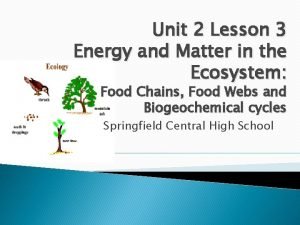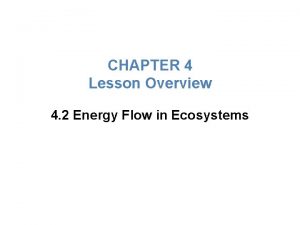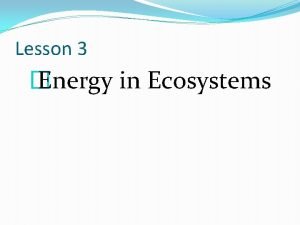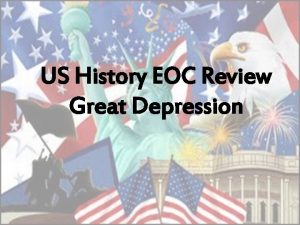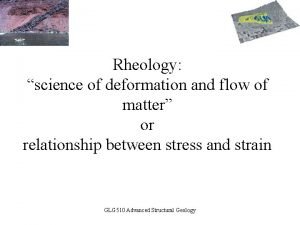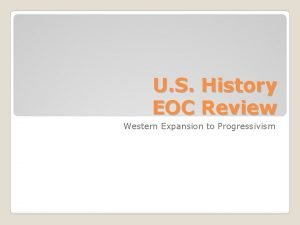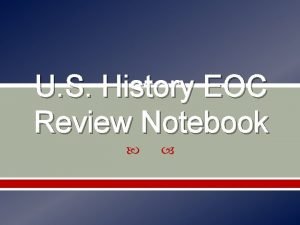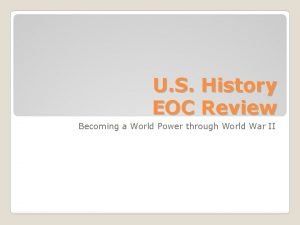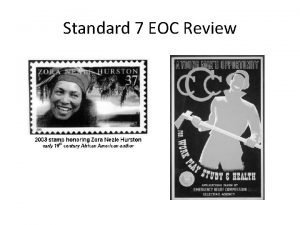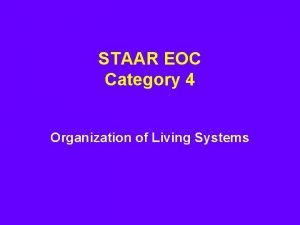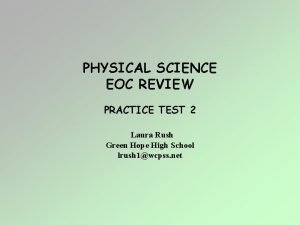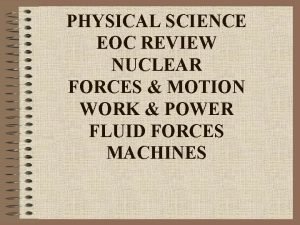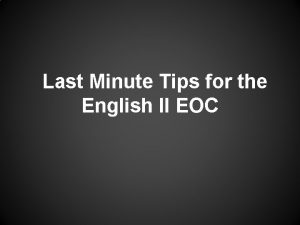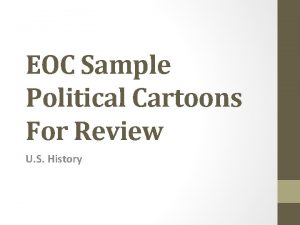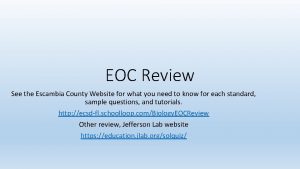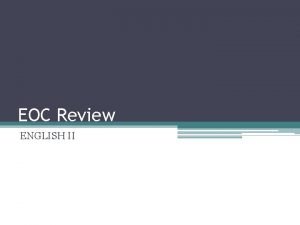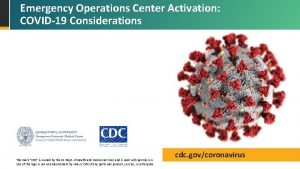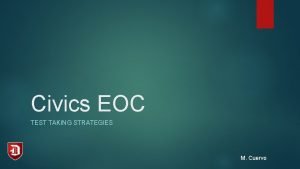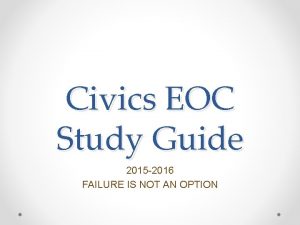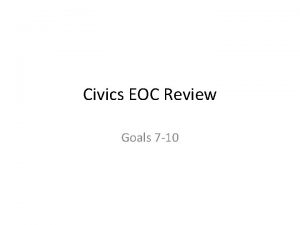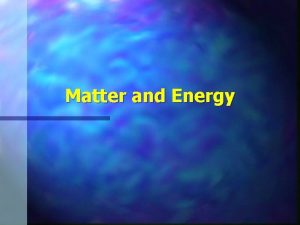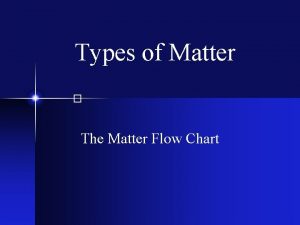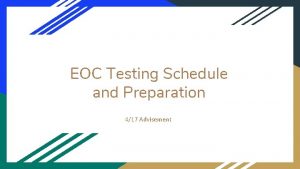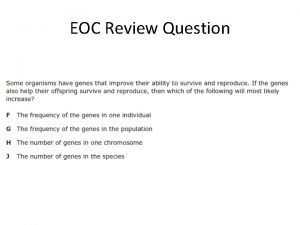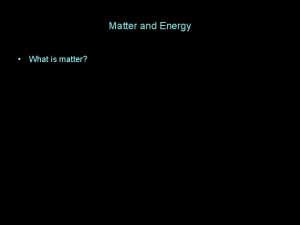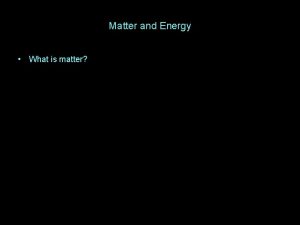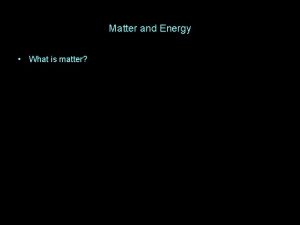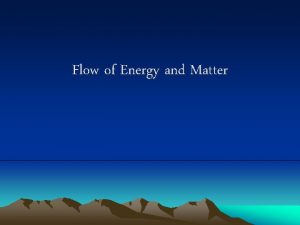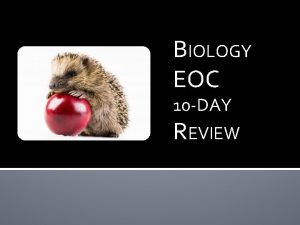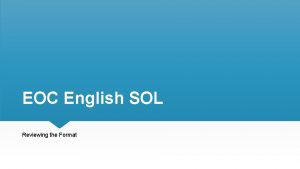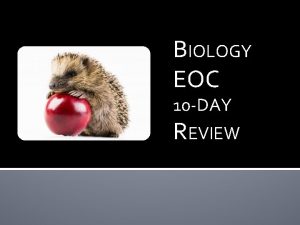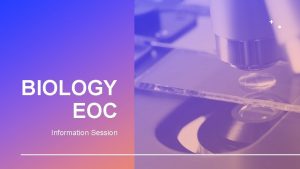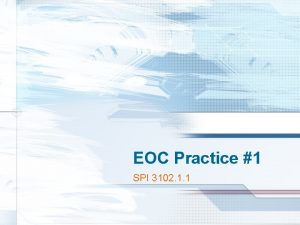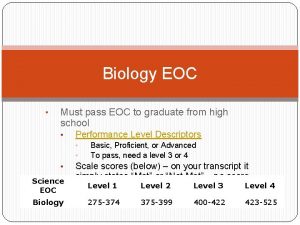FLOW of MATTER and ENERGY EOC Lesson 11










































- Slides: 42

FLOW of MATTER and ENERGY EOC Lesson 11: Energy flow through an ecosystem

Where does most of the original energy come from?


Producers Consumers Decomposers Use absorbed light to make their own food through photosynthesis An organism that obtains its food by eating other organisms Classified based on their food source Primary and secondary consumers Gets energy by breaking down the remains of dead organisms Return chemicals to environment Plants, green algae, and some bacteria All animals, many protists, Fungi, many types of some bacteria

Trophic levels and food chain • Trophic level = each feeding level • Food chain is used to show the energy flow from one organism to the next


Food web • Food chain has only 1 path for the flow of energy. Food webs are used to represent several food chains because there are more than one producer and decomposer.



Herbivores Carnivores Omnivores Feed on or almost Feed on or mainly Eats both plants entirely on plants on animals and animals

Energy Pyramid • Shows the energy loss between the trophic levels in an ecosystem • Only about 10% of the energy is passed from one trophic level to the next • Rest is “lost” to the environment as heat



Lesson 12: aerobic and anaerobic respiration

Chemical energy • Stored in carbohydrates and other organic compounds • Used for cellular activity • Released through the process of respiration • Mitochondria is the organelle that releases the energy • This energy is stored in a compound = ATP (adenosine triphosphate)

ATP – nucleotide and 2 phosphate groups. Loses a phosphate to release energy and becomes ADP.

Aerobic vs. anaerobic • Aerobic • Requires oxygen • cellular respiration • Produces a lot of energy • Anaerobic • Does not require oxygen • Fermentation • Produces a little energy

Cellular respiration • Takes place in the mitochondria • C 6 H 12 O 6 + 6 O 2 6 CO 2 + 6 H 20 + energy Glycolysis Krebs Cycle (if oxygen is present) Electron transport chain Splits glucose molecule into pyruvic acid cytoplasm Produces 2 ATP Occurs in both aerobic and anaerobic respiration Also known as citric acid cycle High energy electrons from Takes place in mitochondria Krebs cycle to convert ADP to Breaks down pyruvic acid into ATP carbon dioxide and ATP Takes place in mitochondria Together produce 36 ATP = total of 38 ATP molecules

Lactic Acid Fermentation Alcoholic Fermentation Converts pyruvic acid into lactic Convert pyruvic acid into ethyl acid alcohol Yogurt and cheese Wine, beer, bread Muscles during strenuous excerise Both processes are anaerobic respiration





Lesson 13: Photosynthesis and Cellular Respiration

Photosynthesis • RAW materials: carbon, hydrogen, oxygen • Use sunlight for energy • Carbon dioxide + water + glucose + oxygen • Takes place in the chloroplast





Lesson 14: Biogeochemical Cycles

4 systems that make up earth • Land • Air • Water • And organisms • These processes can be altered by human activities or by natural events

Biogeochemical cycles and Reservoirs • Biogeochemical cycles • Connection between livings things and Earth’s systems • Involve the movements of organic and inorganic chemicals through the lithosphere, hydrosphere, atmosphere, and biosphere • Reservoirs • Places where various chemicals are stored and from which they flow and are recycled • Carbon from rocks, as gas in atmosphere, and dissolved in water in tissues

4 main processes of the water cycle Evaporation Transpiration Condensation Precipitation Water changing Movement of Water vapor from liquid to a water from turns to liquid gas plants into the air from the openings in their leaves Water that falls back to earth into bodies of water, land to be absorbed or flow off as runoff to resevoirs

Altered water cycle: impact on environment • create dams which displace plants and animals which lived there, they can no longer reach their breeding grounds • Irrigation • Climate change: increase in global temperatures change the patterns of precipitation and evaporation


Nitrogen cycle – continuous movement of nitrogen through each of Earth’s systems • 78% of Earth’s atmosphere • Bacteria plays a critical role in the nitrogen cycle. Since most living things cannot use it directly, bacteria convert the nitrogen gas to ammonia and nitrates which can be used. • Used to make proteins • Overplanting of crops uses up the nitrogen in the soil, clear-cutting of forest expose soil to erosion carrying away nitrogen-rich soil, artificial fertilizers run off into nearby bodies of water causing an overgrowth of algae (algal blooms) which in turn uses up oxygen and kills off the organisms that lived in this ecosystem



Carbon-oxygen cycle: two cycles that are studied together between atmosphere and living things. • Includes photosynthesis and cellular respiration • Oxygen is used to burn fuel • death and decomposition of living things forms fossil fuels which store large amounts of carbon • Effects: combination of forest destruction and burning of fossil fuels increases the amount of carbon in the atmosphere. As a result, there is an increase in temperature all over the planet.



 Flow energy review
Flow energy review Flow of energy vs flow of matter
Flow of energy vs flow of matter Phosphorus cycle
Phosphorus cycle The science duo physical and chemical changes
The science duo physical and chemical changes Grey vs white matter
Grey vs white matter Primary taste cortex
Primary taste cortex Gray matter and white matter
Gray matter and white matter Gray matter vs white matter
Gray matter vs white matter Energy energy transfer and general energy analysis
Energy energy transfer and general energy analysis Energy energy transfer and general energy analysis
Energy energy transfer and general energy analysis Chapter 4 lesson 2 energy flow in ecosystems
Chapter 4 lesson 2 energy flow in ecosystems Chapter 4 lesson 2 energy flow in ecosystems answer key
Chapter 4 lesson 2 energy flow in ecosystems answer key Primary consumer definition
Primary consumer definition Main idea
Main idea Deformation and flow of matter
Deformation and flow of matter Section 1 composition of matter
Section 1 composition of matter Section 1 composition of matter
Section 1 composition of matter Chapter 2 matter section 1 classifying matter answer key
Chapter 2 matter section 1 classifying matter answer key Classification of matter section 1 composition of matter
Classification of matter section 1 composition of matter Florida us history eoc review
Florida us history eoc review Pbs eoc review
Pbs eoc review Us cavalry general whose unwise and reckless
Us cavalry general whose unwise and reckless Us history eoc review notebook
Us history eoc review notebook This area along the german/belgian border was demilitarized
This area along the german/belgian border was demilitarized Us history eoc review activities
Us history eoc review activities Eoc biology test
Eoc biology test English 2 staar test
English 2 staar test Standard 7 eoc review
Standard 7 eoc review Peripheral nervous system consists of
Peripheral nervous system consists of Physical science eoc practice test
Physical science eoc practice test Physical science eoc review
Physical science eoc review English eoc tips
English eoc tips Hbs end of course exam review
Hbs end of course exam review Plenty for beautification political cartoon
Plenty for beautification political cartoon Civics.360
Civics.360 Escambia biology
Escambia biology English eoc review
English eoc review What is an elegy in literature
What is an elegy in literature In a normal operations/steady state eoc activation level,
In a normal operations/steady state eoc activation level, Civics 360.org
Civics 360.org Civics eoc study guide
Civics eoc study guide Civics eoc review
Civics eoc review Civics 360.org
Civics 360.org


